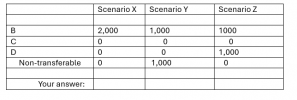Brendan Burgess
Founder
- Messages
- 53,292
In the example shown in post #89 there are:
1,000 votes which express a first preference for A and no second preference (Lets call them Group 1)
1,000 votes which express a first preference for A and a second preference for B (Lets call them Group 2)
I see nothing wrong with allocating Group 1 to A, and transferring all of Group 2 to B, which is the effect that the Irish system has. In fact this is entirely appropriate. Every one of the 2,000 votes is effective. No votes are discarded.
Hi Freelance
I am trying to understand your point here.
"I see nothing wrong with allocating Group 1 (A0) to A, and transferring all of Group 2 (AB) to B,"
By the same token, you should see nothing wrong with allocating all of the ABs to A and then having 1,000 non-transferables.
2,000 people voted for A.
A needed only half of their vote, so what do we do with the other half?
For the ABs we give the 1000 @ .5 to B.
For the A0s , we do nothing with them as they did not specify a preference.
Brendan




